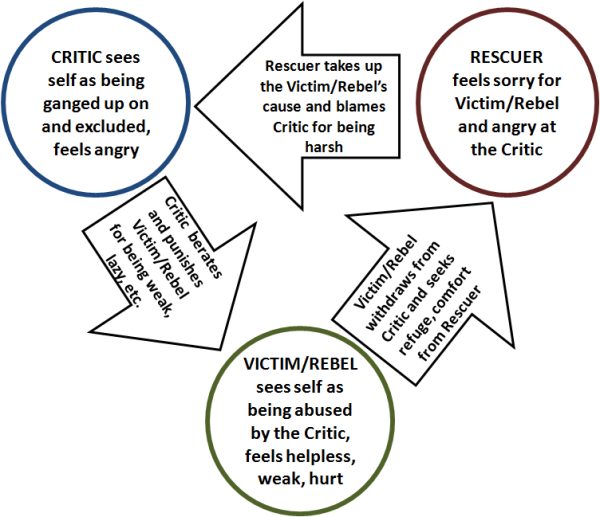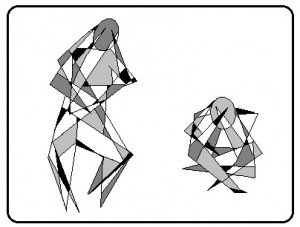The following is an article that I wrote about twenty years ago, yet my message is much the same now, though I have elaborated on it and integrated it with other themes, particularly the explorations of relationships as organic systems, rather than in terms of simple cause-and-effect relationships. The Beetle Bailey comic strip by Mort Walker that I cite is from October 6, 1991, and it continues to be a timeless pattern.
THE CRITIC – VICTIM/REBEL – RESCUER CYCLE
Adapted from the Persecutor-Victim-Rescuer Cycle, by Stephen Karpman, from the book, Games Alcohols Play, by Claude Steiner (1971)
VICIOUS CYCLES IN RELATIONSHIPS
AND TIPS ON HOW TO STOP SPINNING YOUR WHEELS
By Bob Daniel, Ph.D.
Tidewater Psychotherapy Services
How often have you found yourself caught up in a struggle with a spouse, friend, or other significant person, and the harder you try to resolve the problem, the worse the situation becomes? And despite realizing this, you are compelled to keep trying the same approach, only harder? Chances are that your partner in this struggle is experiencing a similar frustration and compulsion, though from a quite different perspective. These features define the basic vicious cycle pattern of interaction.
An example will illustrate this phenomenon. In a “Beetle Bailey” comic strip a while back, General Halftrack’s wife scornfully predicts that he will stop off to have several drinks before returning home after golf. He becomes sullen and indignant at her insinuation of his lack of self-discipline. So how does he cope with his distress? That’s right – he finds solace at his favorite bar. We can further assume that Mrs. Halftrack will continue to address her loneliness by nagging him even more for his drinking and absences. Though each spouse has a legitimate need – the wife’s wish for companionship and the husband’s desire for respect and confidence in him – each is responding in a manner that practically negates those possibilities.
ADDICTION AND CODEPENDENCY
This pattern is one of many profiled in the current literature on addictive and codependent behavior. Whatever the outlet – alcohol, drugs, pornography, gambling, food, compulsive shopping, etc. – the addiction offers the addict an escape from the codependent’s demands and provides an impersonal mode of tension relief. This in turn enables the codependent partner to deflect attention away from his or her own inner pain and to focus on the partner’s addictive behavior. The codependent then typically engages in a campaign of complaining, pleading, bribing, blaming, demanding, threatening, and withholding in order to correct and control the partner’s behavior. As we saw in the case of the Halftracks, this only serves to perpetuate the problem.
CRITIC – VICTIM – RESCUER TRIANGLES
The addiction-codependency pattern is only one version of the vicious cycle. Other cycles may involve a third person, with each participant assuming a specialized role. Such is the case with the critic-victim-rescuer cycle. In this pattern the critic blames and punishes the victim, typically for some inadequacy or weakness. The victim feels hurt, rejected, and fearful. Rather than confront the critic, the victim seeks solace from the rescuer, who identifies with the victim’s pain and assumes a protective posture. The rescuer implicitly condones the victim’s retreat by interceding with the critic for patience and understanding for the victim. A frequent implication of this message is that the critic has been cruel and insensitive. The critic feels rejected and alienated by the victim-rescuer alliance and expresses this by blaming the rescuer for coddling the victim and by again criticizing and punishing the victim at the next instance of weakness, thus starting the cycle over. These interactions serve to accentuate the roles of the participants: critic as punitive outcast, victim as helpless dependent, and rescuer as self-sacrificing martyr. These amplified roles in turn strengthen the vicious cycle.
FAMILY TRIANGLES
Families are perhaps the prevalent setting for this triangular cycle, and families with rigidly defined roles are often the most susceptible. In our culture the father commonly serves as disciplinarian, while the mother often provides protection and support. Rigid adherence to these roles tends to polarize the parents into extreme positions, thereby setting up a critic-victim-rescuer cycle. In this case the father places harsh, unrealistic demands on the child and the mother protects the child from even the normal risks required to develop competence and independence. Another version frequently occurs in alcoholic and chaotic families, wherein one parent victimizes the other. In this case the child attempts to fulfill the rescuer role, sacrificing his or her childhood to assume responsibility prematurely. In severe cases of either variation, escalation to abuse and violence is possible, and imminent risk would require the intervention of authorities for protection. Furthermore, these patterns may persist well into the offspring’s adulthood, with these well-learned roles and interactions available to be played out in other settings – including the next generation’s family.
THE PERSISTENCE OF VICIOUS CYCLES
Given the futility of vicious cycles, we might wonder why people stay in these downward spirals. A basic reason is that the roles and interactions are well-learned from our family backgrounds, and we are apprehensive about trying anything new and unfamiliar. Besides the security of the familiar, there also seems to be an innate human tendency to rework frustrating situations until we get them right. This urge even extends to the choice of one’s spouse. It has been observed that the overly responsible children of alcoholics often end up marrying alcoholics or similarly addicted personalities, even when they consciously try not to. Thus, the partners tend to be well-matched in their complementary roles, which further strengthens the grip of the vicious cycle.
Attempts to give up dysfunctional roles often pose threats to the identity upon which our self-esteem is based. Identity involves who we are not, as well as who we are. Persons living out deeply ingrained roles often view other choices as totally alien: “That’s just not me.” A critic will feel comfortable expressing anger but not hurt, which is taken as a sign of weakness. A victim will show hurt and doubt but not anger, which is seen as bad. A rescuer will show hurt and anger for others, yet view doing so for oneself as selfish. These definitions of self narrow the participants’ options and further lock them into their vicious cycle roles.
FINDING THE WAY OUT
Once you recognize that you are in a vicious cycle, how can you escape it? Actually, recognition is a major step, since stepping back to gain perspective releases you from the tunnel vision that keeps you focused on your partner’s role in the struggle. Reflection usually shows that there is no single culprit responsible for the mess, but that each person plays a part. This tends to counter the good vs. evil thinking that often perpetuates the struggle: participants may blame each other and ignore their own choices, or they may attempt to relieve the distress of guilt, inadequacy, or assigned blame through some addictive or otherwise self-destructive behavior. Gaining the perspective it takes to get yourself into the picture enables you to see the overall problem and to explore new options to resolve it. When both partners in a vicious cycle get an overview of their dilemma, it can lead to an exciting process of mutual discovery.
Even if only one partner were wanting to work on breaking the cycle, simply declining to participate in the vicious cycle in the usual way can help. If Mrs. Halftrack stops complaining, the general might start assuming responsibility for his drinking, since he can no longer blame it on her nagging. Or if he could stop drinking to relieve his distress, she might begin attending to her own loneliness. Note that these are only possibilities, not guarantees. You can influence others, but you cannot control them. The paradox of influence is that it works best when you give up the illusion of control. Thus, the most effective way out of a vicious cycle is to work on changing yourself. Even then, it might not be enough, especially if your partner is deeply committed to his or her role. Then, getting out of the vicious cycle may mean getting out of the relationship.
GETTING HELP
Breaking a vicious cycle can be a truly difficult process, and support and guidance can be critical to its success. If you are prone to vicious cycles, then your self-image will tend to be narrowly defined by your assumed role, with significant aspects of the psyche relegated to the “not me.” Just as you require a mirror to reflect your body image, you come to see your personal self reflected in the eyes of others. Thus, friends outside your vicious cycle can help you discover the disowned aspects of yourself that can help free you from the cycle. Yet they may also become involved in the vicious cycle themselves, often in the rescuer role. This usually just reinforces the narrow view of yourself defined by the vicious cycle. It thus is important to assess their advice and support, rather than simply accepting it on blind faith. Support groups, such as those focused around addictions and codependency, can be quite beneficial, since the members tend to be at various stages of recovery and disengagement from vicious cycles. Psychotherapy can also be quite helpful. While their techniques will vary according to theoretical orientation, therapists have the conceptual tools to support disengagement from vicious cycles. Furthermore, therapists have often undergone extensive training and self-exploration to avoid getting caught up in the vicious cycles themselves in providing therapy.
THE REWARDS: SELF-ESTEEM AND INTIMACY
Escaping the vicious cycles offers the opportunity to expand one’s identity and to establish emotional intimacy with one’s partner. A victim who uses her previously disowned anger to challenge her critics can become self-confident and gain the respect of others. A rescuer who learns to advocate for herself and put her needs first can find greater satisfaction in relationships and discover her intrinsic self-worth. A critic who admits his pain and vulnerability often finds greater acceptance from others, which helps to release him from the pressure of his own self-imposed unrealistic expectations. Additionally, the self-defeating roles themselves can be transformed in healthier modes of relating. A harsh critic who softens his judgmentalism can serve as an instructive mentor, guide or coach. A rescuer who refrains from taking on others’ problems can care for others, rather than take care of them. A victim who assumes responsibility for dealing with his problems can learn from authority figures rather than avoiding them as critics or seeking refuge through them as rescuers. Furthermore, his expression of feelings can serve the self-disclosure required for his partners’ empathy. When partners alternate among these various roles, then mutual support and intimacy become possible. While breaking out of vicious cycle roles is difficult, the rewards of healthy self-esteem and enhanced intimacy are well worth the effort.
Dr. Bob Daniel is a Licensed Clinical Psychologist in private practice with Tidewater Psychotherapy Services in Virginia.

